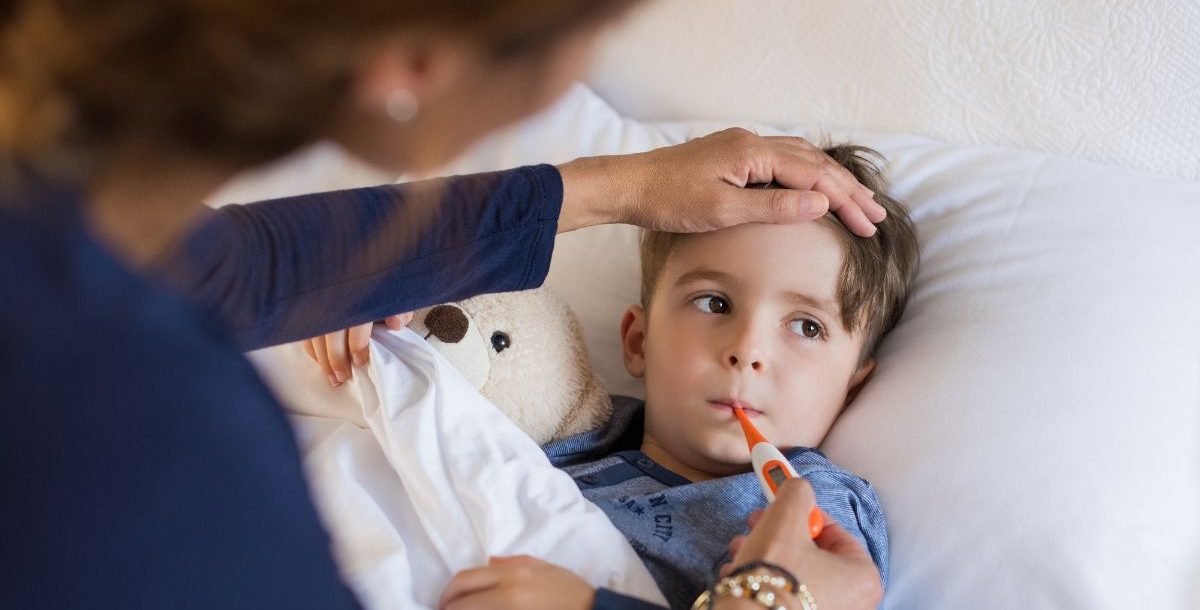Fevers can be easy to panic about, especially in the middle of the night and your little one is uncomfortable. Fevers in children are common and, in many cases, not dangerous. However, recognizing a high fever in kids can help you know when to call your doctor.
What is a fever?
A fever isn’t an illness itself; it’s actually a sign that the immune system is doing its job. When your child has a fever, it usually means their body is trying to fight an infection. The rise in body temperature helps slow down the growth of viruses and bacteria, giving the body a better chance at healing.
A normal body temperature is about 98.6 degrees Fahrenheit but can vary slightly. Doctors consider a temperature of 100.4 or higher a fever. While this might sound alarming, it’s often the body’s natural way of coping with illness.
If your child’s fever is concerning, make an appointment with your pediatrician or family medicine provider.
When is a fever high?
The number on the thermometer matters. A temperature greater than 100.4 degrees Fahrenheit means your child officially has a fever. However, not all fevers require urgent care. Here’s a general guide:
- Low-grade fever: 100.4 to 102
- Moderate fever: 102 to 104
- High fever: 104 and above
A high fever in kids can be scary, but it doesn’t always mean something serious is happening. Look at the whole picture, like how your child is acting, eating and drinking.
When to call your doctor
While most fevers run their course without trouble, there are times you should seek medical help:
- Your baby is younger than 3 months and has a temperature of 100.4 or higher. Even a low fever in newborns can signal a serious infection.
- Your child has a fever higher than 104 that doesn’t come down with fever-reducing medications like acetaminophen or ibuprofen.
- Your child seems unusually drowsy, irritable or it’s hard to wake them up.
- They have trouble breathing, a rash that doesn’t fade when pressed or they keep vomiting.
- Their fever lasts more than three days and doesn’t have a clear cause.
Also, keep an eye out for febrile seizures. These are convulsions that can happen when a child’s temperature rises too quickly. They’re most common in kids between 6 months and 5 years old.
While they look scary, most febrile seizures are brief and don’t cause long-term harm. Still, if your child has one, get medical attention. If it’s your child’s first seizure or lasts more than five minutes, go to the emergency department.
Treating a fever at home
You don’t always have to treat a fever. If your child is playing, drinking and seems mostly OK, you might not need to give any medication at all. But if they’re uncomfortable or not sleeping well, you can use acetaminophen or ibuprofen to help reduce the fever.
Never give aspirin to children, as it’s linked to a rare but serious condition called Reye’s syndrome.
Keep your child comfortable
Whether you give medication or not, the goal is to keep your child comfortable:
- Dress them in light clothing.
- Offer plenty of fluids to prevent dehydration, like water, clear broths or sports drinks.
- Keep their room at a moderate temperature.
- Encourage them to rest, but don’t force them to stay in bed if they feel like moving around.
How we can help
Fevers in children can be worrying, especially when they spike suddenly or don’t go down. A high fever is often a sign that the immune system is kicking in to fight infection. In most cases, treating a fever is about making your child comfortable while their body does the work.
Stay calm, keep the fluids coming and don’t hesitate to reach out to your pediatrician when you need it. No one knows your child better than you do. If something doesn’t feel right, call your pediatrician, even if it’s just for reassurance. Sometimes it’s not just the number on the thermometer, but how your child is acting overall.
Learn about the primary care and pediatric services we offer at Bon Secours.





